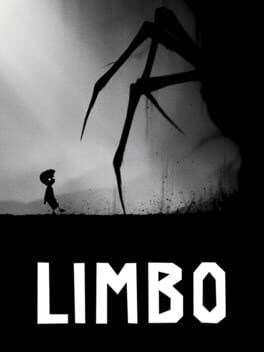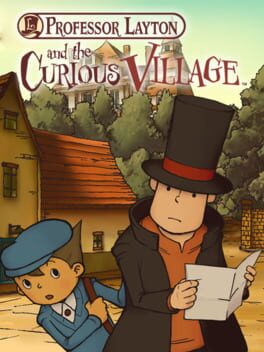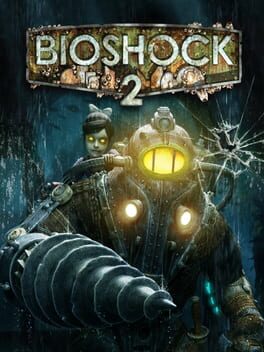DPN137
69 Reviews liked by DPN137
Bloodborne
2015
The best game in the series - The combat finally feels weighty and impactful, the characters are all interesting and relatable while avoiding being over the top, and the set pieces are fucking unmatched. Not having a supernatural element to the story, unlike all the previous entries, is also a big plus.
Limbo
2010
Disney's Tarzan
1999
Demon's Souls
2009
Praising its atmosphere while admonishing its unrefined gameplay is the obvious route to go for a review of Demon’s Souls. Some people aren’t drawn in by its dark tone, some can’t adjust to its weighty combat, this is the sort of analytical static that will probably surround it forever. However, there is one aspect to it that completely eclipses its successors which is a little less obvious, in the brilliant way it structures itself as an open-ended game. Just as Demon’s Souls has the endless static of “atmospheric but clunky”, all three Dark Souls games carry the criticism of “great when you don’t have to constantly warp between locations” to some extent. So, how did Demon’s Souls actually manage to get it right on the first try?
The best way to point out what makes it so good is to start with the counterpoint of Dark Souls in particular. After gaining the ability to warp between bonfires, the first of the four open-ended areas you tackle will probably be a decent challenge, but after that, your character will be so kitted out that the rest will be trivial. Not only that, but the quality of these areas varies dramatically, with Lost Izalith perhaps being the nadir of the entire series. Meanwhile, Demon’s Souls doesn’t just set you loose to tackle each of its zones in a linear fashion, it encourages you to mix it up by giving each area multiple layers of incentives. The most obvious is the supplies you can farm from each area: healing grass in Boletaria, upgrade materials in Stonefang, magic spice in Latria, souls in Shrine of Storms, and lotuses in Valley of Defilement. The next layer is with the titular souls themselves, which heavily incentivize players to challenge themselves for great rewards. Magic users don’t just run to a shop and buy the best abilities, they have to brave one of the most punishing areas of the game for a basic kit, then actually defeat bosses and use their souls for the best abilities. Similarly, miracles can provide great utility, but you have to actually go defeat some bosses and use their souls to earn that advantage. The last layer is the way that each of these incentives were intelligently balanced around which players would want to come there first. Strength-based warriors would want to go to Stonefang for its upgrade materials, but most of the enemies there are highly resistant to slashing damage. Mages want to go to Latria, but it’s filled with a mix of low-level enemies to waste your spell power alongside highly powerful spellcasters who can demolish low-HP builds in one shot.
A counterargument to all of this may, counterintuitively, arise from the biggest fans of the game. If you know where everything is, you probably only need to kill three or four bosses in total before your build is online. However, this is a case where you need to put yourself back in the mindset of a blind playthrough. This game was designed for people who had never seen anything like this before, and the designers worked hard to convey the information we can take for granted in a naturalistic way. Players can be counted on to try and find the most efficient path forward, so by mixing layers of incentives with a difficulty level that forces characters outside their comfort zone, players wordlessly get sucked into exploring every corner as a real adventurer. They make decisions about which areas are worth exploring right now, which to avoid, and which bosses might give the most useful spells, relevant weapons, or simply the highest amount of souls. Players poke at the defenses, make mental notes, explore, and learn while jumping from place to place and making progress one step at a time. This is the genius at the heart of the game’s nonlinearity: in breaking into distinct areas, it constructs a cohesive adventure. I think that’s a major factor of why the hostile atmosphere is a commonly discussed topic, since it’s such a perfect fit for a game that wants you to feel threatened and to be observant for any possible advantage. Really though, it’s not just the atmosphere, it’s the mechanics, difficulty, and even its story that harmoniously build upon its open structure to create one of the best adventure experiences in gaming. Other games may have refined its ideas, but none of them quite replicate the unique feel that Demon’s Souls achieved. If you haven’t played it, please give it a try, it’s been a longstanding member of my top ten for all these reasons and more.
P.S. I haven’t played the remake or even seen much footage from it, so I can’t comment if it’s an adequate substitution. If a PS5 is all you have available, it would probably be fine, but when in doubt, I always lean towards the original.
The best way to point out what makes it so good is to start with the counterpoint of Dark Souls in particular. After gaining the ability to warp between bonfires, the first of the four open-ended areas you tackle will probably be a decent challenge, but after that, your character will be so kitted out that the rest will be trivial. Not only that, but the quality of these areas varies dramatically, with Lost Izalith perhaps being the nadir of the entire series. Meanwhile, Demon’s Souls doesn’t just set you loose to tackle each of its zones in a linear fashion, it encourages you to mix it up by giving each area multiple layers of incentives. The most obvious is the supplies you can farm from each area: healing grass in Boletaria, upgrade materials in Stonefang, magic spice in Latria, souls in Shrine of Storms, and lotuses in Valley of Defilement. The next layer is with the titular souls themselves, which heavily incentivize players to challenge themselves for great rewards. Magic users don’t just run to a shop and buy the best abilities, they have to brave one of the most punishing areas of the game for a basic kit, then actually defeat bosses and use their souls for the best abilities. Similarly, miracles can provide great utility, but you have to actually go defeat some bosses and use their souls to earn that advantage. The last layer is the way that each of these incentives were intelligently balanced around which players would want to come there first. Strength-based warriors would want to go to Stonefang for its upgrade materials, but most of the enemies there are highly resistant to slashing damage. Mages want to go to Latria, but it’s filled with a mix of low-level enemies to waste your spell power alongside highly powerful spellcasters who can demolish low-HP builds in one shot.
A counterargument to all of this may, counterintuitively, arise from the biggest fans of the game. If you know where everything is, you probably only need to kill three or four bosses in total before your build is online. However, this is a case where you need to put yourself back in the mindset of a blind playthrough. This game was designed for people who had never seen anything like this before, and the designers worked hard to convey the information we can take for granted in a naturalistic way. Players can be counted on to try and find the most efficient path forward, so by mixing layers of incentives with a difficulty level that forces characters outside their comfort zone, players wordlessly get sucked into exploring every corner as a real adventurer. They make decisions about which areas are worth exploring right now, which to avoid, and which bosses might give the most useful spells, relevant weapons, or simply the highest amount of souls. Players poke at the defenses, make mental notes, explore, and learn while jumping from place to place and making progress one step at a time. This is the genius at the heart of the game’s nonlinearity: in breaking into distinct areas, it constructs a cohesive adventure. I think that’s a major factor of why the hostile atmosphere is a commonly discussed topic, since it’s such a perfect fit for a game that wants you to feel threatened and to be observant for any possible advantage. Really though, it’s not just the atmosphere, it’s the mechanics, difficulty, and even its story that harmoniously build upon its open structure to create one of the best adventure experiences in gaming. Other games may have refined its ideas, but none of them quite replicate the unique feel that Demon’s Souls achieved. If you haven’t played it, please give it a try, it’s been a longstanding member of my top ten for all these reasons and more.
P.S. I haven’t played the remake or even seen much footage from it, so I can’t comment if it’s an adequate substitution. If a PS5 is all you have available, it would probably be fine, but when in doubt, I always lean towards the original.
Snooker 19
2019
Forza Horizon 4
2018
It's tough for me to rate these games. When I play one, I play a LOT of it, and I have a good time, but they always leave me feeling empty. I hate the grind and the feeling of never being able to see all the content -- it's the completionist in me. And on top of that there's the absolutely insulting amount of advertising for DLC barfed all over every screen and every menu. It's borderline parody and actively turns me off to the whole thing.
Looks great, driving's great, but the vibe is phony and I truly hate the obtrusive attempts at game-as-a-service shit. I don't want to play this for 1000 hours to unlock everything (if that's even possible).
Looks great, driving's great, but the vibe is phony and I truly hate the obtrusive attempts at game-as-a-service shit. I don't want to play this for 1000 hours to unlock everything (if that's even possible).
Visual novels are often dismissed as low-effort titles, but it’s important to recognize the role they play in the modern gaming landscape. With the classic adventure genre being functionally dead, visual novels have taken their place as the format of choice for mixing a focused narrative with thoughtful gameplay. This can come in the form of something like Danganronpa, where the gameplay is detective work directly linked to the events of the story, or something more like Professor Layton, where its library of puzzles are only loosely contextualized within the narrative. In both cases, it’s a tough balancing act to ensure each part isn’t holding back the other, with riddles that are either too scarce to appeal to puzzle lovers or too frequent to maintain a good narrative pace. Layton’s approach heavily favors the puzzle side, but it made some smart concessions with its story to ensure everyone could enjoy the game. While it does require you to complete a certain number of puzzles, players have the freedom to skip the ones they’re stuck on, and since they’re given by townsfolk who may be unavailable at certain times, missed puzzles are conveniently moved to a centralized location at the end of each chapter. On the other side, the story has a lot of intriguing little mysteries, but there’s never a time where you have to sit and listen to people chat for minutes at a time. The plot is free of unnecessary drama, acknowledging that the central thread of the game is in solving mysteries, not character conflict. Characters are introduced and given a few sentences of establishment, then they reveal a new story detail, and present a new puzzle. It’s a concise way of keeping everyone happy, especially when combined with the aforementioned puzzle streamlining. The only problem the game really has is how, in a struggle to come up with 120+ unique puzzles, it flips from logic problems to semantic riddles without warning, occasionally cheating players with a deliberately misleading premise. These are very much the minority however, and the quality speaks for itself when someone who’s close to double the target age could still enjoy the game and have to spend time working out the tougher puzzles. The best way to sum it up would be that it’s just like the animated movies it seeks to emulate, in that its earnest simplicity could charm just about anyone, even if it probably won’t end up being an all-time favorite.
BioShock 2
2010
Doom Eternal
2020
Doom Eternal has enjoyed a highly positive reception, but there’s been an ongoing controversy regarding the game’s Marauder enemies. They’re by far the most complex enemies and mirror many of the players’ own skills, so as soon one enters the fray, the demon-slaying power fantasy becomes a tense duel to the death. Such a common action game trope hardly seems worthy of debate, but the counterargument is that they hurt the pace enough to where the free-flowing core of the combat breaks down entirely. With the Marauder seizing control of the battle with his speed and persistence, players can’t comfortably glory kill other enemies for health, use the chainsaw for ammo, or switch their focus to other enemies. They instead have to follow the very specific instructions given to them in a pop-up tutorial, which I will quote in full:
The Marauder is a defensive powerhouse.
Stand too close, he uses his Shotgun.
Stand too far away, he throws projectiles.
Keep him at mid-range, counter his attack when his eyes flash green; otherwise, he blocks your shots.
The Marauder is resistant to Super Weapons.
This “butter-zone” between standing too near or far is an incredibly hard thing to balance, especially when being chased and blasted with attacks, so it’s easy to sympathize with players who struggle with it. It’s also easy to sympathize with the expert players who have no trouble at all, because they don’t even need to follow those guidelines. In fact, no one does, because those instructions are incomplete at best, and completely misleading at worst. Players can instead just stagger the Marauder as he charges with his axe, and chain it with another powerful blast as he stumbles for even more damage. So why don’t players just do this instead?
The best way to explain why is by comparing the Marauder to the other enemies in the game, with a great example being the Cacodemon. Its pop-up tutorial states the following:
The Cacodemon is a Pressure Demon with a powerful close-range bite.
If you can fire a Sticky Bomb or Frag Grenade into its mouth, it instantly Staggers.
This stagger is not only a 100% consistent glory-kill setup, it’s inarguably the most efficient way to take down these enemies. Since grenades operate on a cooldown instead of ammunition capacity, and the ammo requirement from other weapons can be high, the strong majority of Cacodemons killed in the average playthrough will be through the tooltip’s grenade-glory double tap. Other tutorials are fairly comparable: players are told to shoot the armor off Mancubi, the guns off Revenants and Arachnotrons, to hit the back of the Pinkies, and so on. While these are useful hints, they communicate a worrying precedent to the player that the strategy outlined by the tooltip is what you should always try to do. By having information spoon-fed before the enemy is even visible on screen, players are being trained to turn their brain off and follow the instructions. Another good point of comparison would be the Shield Soldier, the other enemy in the game who prominently uses an energy shield to block the player’s shots. They’re common enemies, so players will be used to chainsawing through them, throwing explosives behind them, or just using the BFG. If you use these same strategies against the Marauder however, none of them will work, which isn’t a problem in itself, but it fits the pattern of Doom Eternal’s poorly handled conveyance.
Put simply, conveyance is how a game communicates its rules to the player, and this is the heart of what the real problem is. The Marauder is simply where it came to a head, where a misleading tutorial collided with players disincentivized to think critically, thanks to a series of patronizing explanations of dominant strategies. The easy answer may be to just turn them off, but when disabling that setting also turns off help for how contextual gimmicks work, there’s no good solution. The combat has also been balanced around the player knowing these tips and using the dominant strategies they outline, weighing down the player’s capacity for mechanical expressiveness. It's not just the Marauder that's impacted, the player's entire mentality when engaging with enemies suffers from the rigidity of this design. It makes sense that with all the new features in Doom Eternal, the developers wanted to tie enemies to specific mechanics to ensure their use, but depth isn’t just a measure of how many decisions a player could make, but how many they’re actively incentivized to make.
If players only require an active sense of incentive though, doesn’t that bring us into a paradox, where the Marauder’s poor tutorial, and hidden better strategy, could be seen as an incentive for players to think for themselves? It may seem like I’m contradicting myself by acknowledging that’s how certain players will see it, but when games are such subjective experiences, analysis can only go as far as the positive and negative reinforcements that affect players on a general level. There are lots of Doom fans who will rise to the challenge like this and have an amazing time experimenting with the crazy amount of toys the game lets you play with, but the majority of players won’t bother to put in the effort unless prodded to do so. With fewer explicit tutorials and combat based around a more flexible variety of ways to counter enemies in general, players would be primed to test their entire arsenal against each new enemy and experience the joy of mechanical discovery action games are all about.
The Marauder is a defensive powerhouse.
Stand too close, he uses his Shotgun.
Stand too far away, he throws projectiles.
Keep him at mid-range, counter his attack when his eyes flash green; otherwise, he blocks your shots.
The Marauder is resistant to Super Weapons.
This “butter-zone” between standing too near or far is an incredibly hard thing to balance, especially when being chased and blasted with attacks, so it’s easy to sympathize with players who struggle with it. It’s also easy to sympathize with the expert players who have no trouble at all, because they don’t even need to follow those guidelines. In fact, no one does, because those instructions are incomplete at best, and completely misleading at worst. Players can instead just stagger the Marauder as he charges with his axe, and chain it with another powerful blast as he stumbles for even more damage. So why don’t players just do this instead?
The best way to explain why is by comparing the Marauder to the other enemies in the game, with a great example being the Cacodemon. Its pop-up tutorial states the following:
The Cacodemon is a Pressure Demon with a powerful close-range bite.
If you can fire a Sticky Bomb or Frag Grenade into its mouth, it instantly Staggers.
This stagger is not only a 100% consistent glory-kill setup, it’s inarguably the most efficient way to take down these enemies. Since grenades operate on a cooldown instead of ammunition capacity, and the ammo requirement from other weapons can be high, the strong majority of Cacodemons killed in the average playthrough will be through the tooltip’s grenade-glory double tap. Other tutorials are fairly comparable: players are told to shoot the armor off Mancubi, the guns off Revenants and Arachnotrons, to hit the back of the Pinkies, and so on. While these are useful hints, they communicate a worrying precedent to the player that the strategy outlined by the tooltip is what you should always try to do. By having information spoon-fed before the enemy is even visible on screen, players are being trained to turn their brain off and follow the instructions. Another good point of comparison would be the Shield Soldier, the other enemy in the game who prominently uses an energy shield to block the player’s shots. They’re common enemies, so players will be used to chainsawing through them, throwing explosives behind them, or just using the BFG. If you use these same strategies against the Marauder however, none of them will work, which isn’t a problem in itself, but it fits the pattern of Doom Eternal’s poorly handled conveyance.
Put simply, conveyance is how a game communicates its rules to the player, and this is the heart of what the real problem is. The Marauder is simply where it came to a head, where a misleading tutorial collided with players disincentivized to think critically, thanks to a series of patronizing explanations of dominant strategies. The easy answer may be to just turn them off, but when disabling that setting also turns off help for how contextual gimmicks work, there’s no good solution. The combat has also been balanced around the player knowing these tips and using the dominant strategies they outline, weighing down the player’s capacity for mechanical expressiveness. It's not just the Marauder that's impacted, the player's entire mentality when engaging with enemies suffers from the rigidity of this design. It makes sense that with all the new features in Doom Eternal, the developers wanted to tie enemies to specific mechanics to ensure their use, but depth isn’t just a measure of how many decisions a player could make, but how many they’re actively incentivized to make.
If players only require an active sense of incentive though, doesn’t that bring us into a paradox, where the Marauder’s poor tutorial, and hidden better strategy, could be seen as an incentive for players to think for themselves? It may seem like I’m contradicting myself by acknowledging that’s how certain players will see it, but when games are such subjective experiences, analysis can only go as far as the positive and negative reinforcements that affect players on a general level. There are lots of Doom fans who will rise to the challenge like this and have an amazing time experimenting with the crazy amount of toys the game lets you play with, but the majority of players won’t bother to put in the effort unless prodded to do so. With fewer explicit tutorials and combat based around a more flexible variety of ways to counter enemies in general, players would be primed to test their entire arsenal against each new enemy and experience the joy of mechanical discovery action games are all about.














